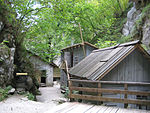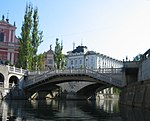Seznam krajev Unescove svetovne dediščine v Sloveniji: Razlika med redakcijama
bom prevedel tale članek iz angleške wp |
Brez povzetka urejanja |
||
| Vrstica 1: | Vrstica 1: | ||
{{Use dmy dates|date=June 2019}} |
{{Use dmy dates|date=June 2019}} |
||
{{Location map+ |Slovenia |width=350 |float=right|caption= |
{{Location map+ |Slovenia |width=350 |float=right|caption=Lokacije krajev Unescove svetovne dediščine v Sloveniji. |places= |
||
{{location map~ |Slovenia |lat=45.662222222222|long=13.988333333333|region=SI-019|position=left|background=#FFFFFF|label=[[ |
{{location map~ |Slovenia |lat=45.662222222222|long=13.988333333333|region=SI-019|position=left|background=#FFFFFF|label=[[Škocjanske jame]] | name= Škocjanske jame}} |
||
{{location map~ |Slovenia |lat=45.982778|long=14.529444|region=SI-037|position=right|background=#FFFFFF|label= [[ |
{{location map~ |Slovenia |lat=45.982778|long=14.529444|region=SI-037|position=right|background=#FFFFFF|label= [[Ig|Kolišča na Barju]] | name= Kolišča na Barju}} |
||
{{location map~ |Slovenia |lat=46.002777777778|long=14.030555555556|region=SI-036|position=top|background=#FFFFFF|label=[[Idrija]] | name= Idrija}} |
{{location map~ |Slovenia |lat=46.002777777778|long=14.030555555556|region=SI-036|position=top|background=#FFFFFF|label=[[Idrija]] | name= Idrija}} |
||
{{location map~ |Slovenia |lat=45.581514|long=14.431542|region=SI-036|position=bottom|background=#FFFFFF|label=[[Snežnik]] | name= Snežnik}} |
{{location map~ |Slovenia |lat=45.581514|long=14.431542|region=SI-036|position=bottom|background=#FFFFFF|label=[[Snežnik]] | name= Snežnik}} |
||
{{location map~ |Slovenia |lat=45.574933|long=14.7992|region=SI-036|position=top|background=#FFFFFF|label=Krokar |name= Krokar}} |
{{location map~ |Slovenia |lat=45.574933|long=14.7992|region=SI-036|position=top|background=#FFFFFF|label=Krokar |name= Krokar}} |
||
}} |
}} |
||
[[Organizacija Združenih narodov za izobraževanje, znanost in kulturo]] (UNESCO) imenuje [[Unescova svetovna dediščina|kraje svetovne dediščine]], ki so pomembni kot naravna ali kulturna dediščina. Kraje svetovne dediščine ureja Unescova konvencija iz leta 1972.<ref>{{cite web |url=https://whc.unesco.org/en/convention/ |title=UNESCO World Heritage Centre The World Heritage Convention |publisher=UNESCO World Heritage Centre |date=25 October 2015}}</ref> Slovenija je po razglasitvi neodvisnosti od Jugoslavije, podpisnice konvencije, ratificirala konvencijo 5. novembra 1992.<ref name="whc.unesco.org">{{cite web |url=https://whc.unesco.org/en/statesparties/si |title=Slovenia |publisher=UNESCO World Heritage Centre |date=25 October 2015}}</ref> |
|||
V letu 2020 so v Sloveniji štirje kraji svetovne dediščine, še pet krajev pa je na poskusnem seznamu. Prvi kraj v Sloveniji, ki je bil vpisan na seznam, so bile [[Škocjanske jame]] leta 1986.<ref name="unesco1">{{cite web |url=https://whc.unesco.org/en/list/390 |title=Škocjan Caves |publisher=UNESCO World Heritage Centre |date=25 October 2015}}</ref> Po letu 2010 so bili vpisani še trije kraji, vsi v okviru mendarodnih nominacij. Leta 2011 so bila na seznam vpisana kolišča na Barju, v okviru [[Prazgodovinska kolišča okoli Alp|Prazgodovinskih kolišč okoli Alp]]<ref name="unesco2">{{cite web |url=https://whc.unesco.org/en/list/1363 |title=Prehistoric pile dwellings around the Alps |publisher=UNESCO World Heritage Centre |date=25 October 2015}}</ref>, 2012 je bila vpisana [[Idrija]] skupaj s španskim [[Almadén]]om<ref name="unescoworldheritagecentre">{{cite web |url=https://whc.unesco.org/en/list/1313 |title=Heritage of Mercury. Almadén and Idrija |publisher=UNESCO World Heritage Centre |date=25 October 2015}}</ref>, leta 2017 pa gozdna rezervata Krokar in Snežnik-Ždrocle, v okviru mednarodne nominacije [[Starodavni prvobitni bukovi gozdovi Karpatov in drugih delov Evrope]].<ref name="unesco3">{{cite web |url=https://whc.unesco.org/en/list/1133 |title=Primeval Beech Forests of the Carpathians and Other Regions of Europe |publisher=UNESCO World Heritage Centre |date=7 July 2017}}</ref> Škocjanske jame in gozdna rezervata spadajo med kraje naravne dediščine, kolišča in Idrija pa sta kraja kulturne dediščine.<ref name="whc.unesco.org" /> |
|||
== |
== Kraji svetovne dediščine == |
||
UNESCO lists sites under [[World Heritage Site#Selection criteria|ten criteria]]; each entry must meet at least one of the criteria. Criteria i through vi are cultural, whereas vii through x are natural.<ref>{{cite web |url=https://whc.unesco.org/en/criteria/ |title=UNESCO World Heritage Centre The Criteria for Selection |publisher=UNESCO World Heritage Centre |accessdate=17 August 2018}}</ref> |
UNESCO lists sites under [[World Heritage Site#Selection criteria|ten criteria]]; each entry must meet at least one of the criteria. Criteria i through vi are cultural, whereas vii through x are natural.<ref>{{cite web |url=https://whc.unesco.org/en/criteria/ |title=UNESCO World Heritage Centre The Criteria for Selection |publisher=UNESCO World Heritage Centre |accessdate=17 August 2018}}</ref> |
||
Redakcija: 20:14, 22. november 2020
Organizacija Združenih narodov za izobraževanje, znanost in kulturo (UNESCO) imenuje kraje svetovne dediščine, ki so pomembni kot naravna ali kulturna dediščina. Kraje svetovne dediščine ureja Unescova konvencija iz leta 1972.[1] Slovenija je po razglasitvi neodvisnosti od Jugoslavije, podpisnice konvencije, ratificirala konvencijo 5. novembra 1992.[2]
V letu 2020 so v Sloveniji štirje kraji svetovne dediščine, še pet krajev pa je na poskusnem seznamu. Prvi kraj v Sloveniji, ki je bil vpisan na seznam, so bile Škocjanske jame leta 1986.[3] Po letu 2010 so bili vpisani še trije kraji, vsi v okviru mendarodnih nominacij. Leta 2011 so bila na seznam vpisana kolišča na Barju, v okviru Prazgodovinskih kolišč okoli Alp[4], 2012 je bila vpisana Idrija skupaj s španskim Almadénom[5], leta 2017 pa gozdna rezervata Krokar in Snežnik-Ždrocle, v okviru mednarodne nominacije Starodavni prvobitni bukovi gozdovi Karpatov in drugih delov Evrope.[6] Škocjanske jame in gozdna rezervata spadajo med kraje naravne dediščine, kolišča in Idrija pa sta kraja kulturne dediščine.[2]
Kraji svetovne dediščine
UNESCO lists sites under ten criteria; each entry must meet at least one of the criteria. Criteria i through vi are cultural, whereas vii through x are natural.[7]
| Site | Image | Location | Year listed | UNESCO data | Description |
|---|---|---|---|---|---|
| Škocjan Caves | 
|
Škocjan (Municipality of Divača) | 1986 | 390; vii, viii (natural) | Cave system and surroundings that represent some of the most significant Karst topography phenomena, including one of the world's largest known underground river canyons. The Karst area is of special importance in the history of earth sciences.[3] |
| Prehistoric pile dwellings around the Alps* | 
|
Municipality of Ig | 2011 | 1363; iv, v (cultural) | Prehistoric pile-dwellings settlements. Excavations in these sites have provided insight into life in prehistoric times during the Neolithic and the Bronze Age in Alpine Europe. Two sites in Slovenia are listed: the pile dwellings in Ig, northern group (kolišča na Igu, severna skupina), and the pile dwellings in Ig, southern group (kolišča na Igu, južna skupina). This is a transnational site that also includes sites in Austria, France, Germany, Italy, and Switzerland.[4] |
| Heritage of Mercury. Almadén and Idrija* | 
|
Idrija | 2012 | 1313; ii, iv (cultural) | Idrija has one of the two largest mercury mines in the world, with mercury being first discovered there in 1490. The site features the infrastructure and technology related to mining and mercury production and bears testimony to the intercontinental trade in mercury, which generated important exchanges between Europe and America over the centuries. The site is shared with the mining town of Almadén, Spain.[5] |
| Primeval Beech Forests of the Carpathians and Other Regions of Europe* | 
|
Municipalities of Kočevje, Ilirska Bistrica, Loška Dolina | 2017 | 1133ter; ix (natural) | The two forest reserves, Krokar and Snežnik – Ždrocle Virgin Forests represent an outstanding example of undisturbed, complex temperate forests. They demonstrate the postglacial expansion process of such forests and exhibit the most complete and comprehensive ecological patterns and processes of pure and mixed stands of European beech across a variety of environmental conditions. The site is a part of transnational site, also shared with Albania, Austria, Belgium, Bulgaria, Croatia, Germany, Italy, Romania, Slovakia, Spain, and Ukraine.[6] |
Tentative list
In addition to the sites inscribed on the World Heritage list, member states can maintain a list of tentative sites that they may consider for nomination. Nominations for the World Heritage list are only accepted if the site was previously listed on the tentative list.[8] As of 2017, Slovenia recorded five sites on its tentative list.[9]
| Site | Image | Location | Year listed | UNESCO criteria | Description |
|---|---|---|---|---|---|
| Fužina hills in Bohinj | 
|
Stara Fužina and Studor v Bohinju (Municipality of Bohinj) | 1994 | ii, v (cultural) | The area that was developed for the particular needs of alpine pasture cattle-raising, with herdsmen gradually moving the cattle up to the highlands in the summer months. Mountainous settlements developed specific farm structures, especially hayracks.[10] |
| Franja Partisan Hospital | 
|
Dolenji Novaki (Municipality of Cerkno) | 2000 | i, iii, iv (cultural) | A clandestine partisan hospital complex, set up during World War II. It had a capacity of up to 120 patients and provided treatment to soldiers of various nationalities. It was never discovered by the enemy forces.[11] |
| Classic Karst | 
|
Karst Plateau | 2015 | vii, viii, ix, x (natural) | Karst Plateau is the region where Karst phenomena were scientifically described for the first time. Continuous human settlement for over 2000 years has created a cultural landscape with a unique identity. The karst region of Slovenia is among the richest areas in Europe in terms of flora and fauna and one of the global "hotspots" of biodiversity.[12] |
| The Walk of Peace from the Alps to the Adriatic – Heritage of the First World War | 
|
Upper Carniola and Slovene Littoral | 2016 | ii, vi (cultural) | The site encompasses the area where the Isonzo front took place during the First World War. Sites include the Russian Chapel on the Vršič Pass, military cemeteries in Log pod Mangartom, Solkan, Štanjel, Gorjansko, and Črniče, Charnel houses in Tolmin and Kobarid, Memorial Church of the Holy Spirit in Javorca, historical areas at Zaprikaj, Mengore, and Sabotin, military chapel in Ladra, and Bohinj Railway.[13] |
| The timeless, humanistic architecture of Jože Plečnik | 
|
Ljubljana and Črna Vas | 2018 | i, iv (cultural) | The site encompasses some of the most prominent works of Jože Plečnik. Sites include St. Michael's Church in Črna Vas, and the following sites in Ljubljana: the promenade along the embankments of the Ljubljanica River and the bridges crossing it, the "Green promenade": Vegova Street with the National and University Library from French Revolution Square to Congress Square and Star Park, Trnovo Bridge, Roman Walls in Mirje, and the All Saints Garden in Žale Cemetery.[14] |
Glej tudi
Viri
- ↑ »UNESCO World Heritage Centre The World Heritage Convention«. UNESCO World Heritage Centre. 25. oktober 2015.
- ↑ 2,0 2,1 »Slovenia«. UNESCO World Heritage Centre. 25. oktober 2015.
- ↑ 3,0 3,1 »Škocjan Caves«. UNESCO World Heritage Centre. 25. oktober 2015.
- ↑ 4,0 4,1 »Prehistoric pile dwellings around the Alps«. UNESCO World Heritage Centre. 25. oktober 2015.
- ↑ 5,0 5,1 »Heritage of Mercury. Almadén and Idrija«. UNESCO World Heritage Centre. 25. oktober 2015.
- ↑ 6,0 6,1 »Primeval Beech Forests of the Carpathians and Other Regions of Europe«. UNESCO World Heritage Centre. 7. julij 2017.
- ↑ »UNESCO World Heritage Centre The Criteria for Selection«. UNESCO World Heritage Centre. Pridobljeno 17. avgusta 2018.
- ↑ »UNESCO World Heritage Centre Tentative Lists«. UNESCO World Heritage Centre. 25. oktober 2015.
- ↑ »UNESCO World Heritage Centre Tentative Lists«. UNESCO World Heritage Centre. 25. oktober 2015.
- ↑ »Fuzina Hills in Bohinj«. UNESCO World Heritage Centre. 25. oktober 2015.
- ↑ »Franja Partisan Hospital«. UNESCO World Heritage Centre. 25. oktober 2015.
- ↑ »Classic Karst«. UNESCO World Heritage Centre. 25. november 2015.
- ↑ »The Walk of Peace from the Alps to the Adriatic – Heritage of the First World War«. UNESCO World Heritage Centre. 12. februar 2016.
- ↑ »The timeless, humanistic architecture of Jože Plečnik«. UNESCO World Heritage Centre. 20. avgust 2018.

